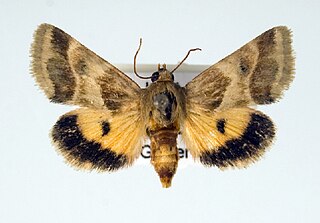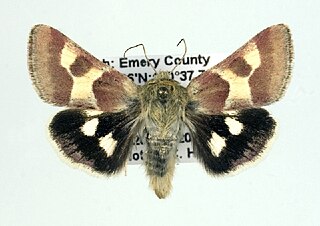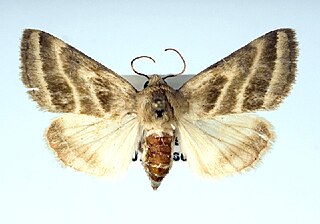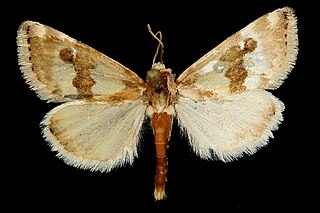
Gaillardia is a genus of flowering plants in the family Asteraceae, native to North and South America. It was named after Maître Gaillard de Charentonneau, an 18th-century French magistrate who was an enthusiastic botanist. The common name may refer to the resemblance of the inflorescence to the brightly patterned blankets made by Native Americans, or to the ability of wild taxa to blanket the ground with colonies. Many cultivars have been bred for ornamental use.

Gaillardia pulchella is a North American species of short-lived perennial or annual flowering plants in the sunflower family.

Liatris, commonly known as gayfeather and blazing star is a genus of flowering plants in the tribe Eupatorieae within the family Asteraceae native to North America. Some species are used as ornamental plants, sometimes in flower bouquets. They are perennials, surviving the winter and resprouting underground corms.

Ericameria is a genus of North American shrubs in the family Asteraceae.

Isocoma, commonly called jimmyweed or goldenweed, is a genus of North American semi-woody shrubs in the family Asteraceae. It is found in the semi-arid areas of Southwestern United States and Mexico.

Schinia ciliata is a moth of the family Noctuidae. It is found from southern California east to Utah, Arizona, Colorado, New Mexico, western Kansas and Oklahoma, and scattered throughout Texas.

Schinia acutilinea, the angled gem or acute-lined flower moth, is a moth of the family Noctuidae. The species was first described by Augustus Radcliffe Grote in 1878. It is found in the dry southern portions of Saskatchewan, Alberta and British Columbia, south across the plains and Great Basin to southern Arizona and California.

Schinia lynx, the lynx flower moth, is a moth of the family Noctuidae. The species was first described by Augustus Radcliffe Grote in 1881. It is found in North America from Wisconsin, southern Ontario, Quebec and Maine, south to Florida and Texas. Records include Colorado, Iowa, Kansas, Nebraska, New York, Maryland, Oklahoma and Oregon.

Schinia albafascia is a moth of the family Noctuidae. It is found south-western Montana and Idaho, west to Oregon, south to central and southern California, east to Arizona, New Mexico and Colorado.

Schinia avemensis, the gold-edged gem, is a moth of the family Noctuidae. The species was first described by Harrison Gray Dyar Jr. in 1904. It is found in only three colonies in the southern prairie provinces of Canada, the Spirit Dunes at Spruce Woods Provincial Park, Manitoba; the Burstall dunes in south-western Saskatchewan; and in a small dune complex in the Red Deer River valley north of Bindloss. It will probably also be found in other active dune complexes in the southern parts of Alberta and Saskatchewan. It has also been recorded from Colorado.
Schinia persimilis, the persimilis flower moth, is a moth of the family Noctuidae. The species was first described by Augustus Radcliffe Grote in 1873. It is found from in western North America from east central Alberta and the Cypress Hills in Saskatchewan north to the southern Yukon, west and south to Colorado, Utah, California and Oregon.

Schinia suetus is a moth of the family Noctuidae first described by Augustus Radcliffe Grote in 1873. It is widespread in the mountains of western North America, from southern Alberta west to British Columbia, south at least to Colorado and California, east to Idaho and New Mexico.

Schinia villosa, the little dark gem, is a moth of the family Noctuidae. The species was first described by Augustus Radcliffe Grote in 1864. In North America, it is mostly a western mountain species, however it has also been found across the plains eastward across Alberta and Saskatchewan to southern Manitoba. To the west it is found up to the coast ranges of Washington and British Columbia, south to Arizona.

Schinia nundina, the goldenrod flower moth, is a moth of the family Noctuidae. The species was first described by Dru Drury in 1773. It is found in North America from Minnesota to southern Ontario and Nova Scotia, south to central Florida and southern Texas. Records include Arizona, Kansas, Nebraska, New York, Maryland, Oklahoma and South Carolina.

Schinia trifascia, the three-lined flower moth, is a moth of the family Noctuidae. The species was first described by Jacob Hübner in 1818. It is found in North America from Ontario and Massachusetts south to Florida and west to Arizona, Colorado and Wyoming. It has also been reported from Louisiana.

Schinia obscurata, the obscure schinia moth, is a moth of the family Noctuidae. It is found from Ontario and Quebec south into the United States, where it has been recorded from Illinois, New Jersey, South Carolina, Wisconsin, Kansas, Montana, Nebraska, North Dakota, Oklahoma and Texas.

Schinia alencis is a moth of the family Noctuidae. It is found from south-eastern Colorado to south-eastern Arizona east to western Oklahoma, northern Texas to south-western and south-eastern Texas.

The reginia primrose moth is a moth of the family Noctuidae. It is found from southern and western Texas, north to the panhandle, north-western Oklahoma, Kansas, Nebraska and west to southern New Mexico and eastern Colorado.















